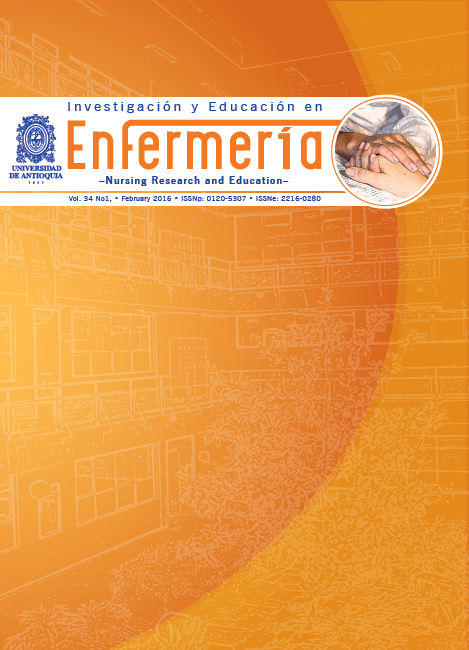Construction and validation of a virtual learning object on intestinal elimination stoma
DOI:
https://doi.org/10.17533/udea.iee.25996Keywords:
Ostomy, distance education, educational technology, nursing.Abstract
Objective. To construct and validate a virtual learning object (VLO) on intestinal elimination stoma.
Methods. Applied, descriptive and quantitative study. In 2014, eight stoma therapists and eight experts in computer science took part of the research. The VLO included four steps: i) planning, ii) construction of VLO and changes of content; iii) development of dynamic, and iv) conclusion and analysis. The VLO was inserted into the Moodle virtual learning environment. The ergonomic and pedagogical validation of the VLO was performed.
Results. The experts appreciated the VLO satisfactorily, and scored it between good and full agreement.
Conclusion. The VLO on intestinal elimination stoma is a tool that can be implemented at undergraduate programs in nursing and continuing education programs for nurses in clinical practice, contributing significantly to improve the theoretical skills necessary for the care of ostomized people safely, with quality and enabling self-care.
How to cite this article: Braga CSR, Andrade EMLR, Luz MHBA, Monteiro AKC, Campos MOOB, Silva FMS, et al. Development and validation of a virtual learning object on intestinal elimination ostomy. Invest Educ Enferm. 2016; 34(1): 120-127
Downloads
References
(1) Brasil. Ministério da Saúde. Secretaria de Vigilância em Saúde. Departamento de Análise de Situação de Saúde. Plano de ações estratégicas para o enfrentamento das doenças crônicas não transmissíveis (DCNT) no Brasil 2011-2022/ Ministério da Saúde. Secretaria de Vigilância em Saúde. Departamento de Análise de Situação de Saúde. – Brasília: Ministério da Saúde. 2011.148 p.: il. – (Série B. Textos Básicos de Saúde).
(2) Instituto Nacional de Câncer (INCA). Estimativa de câncer no Brasil 2012. [cited: May 19, 2013]. Availablefrom: http://www.inca.gov.br/estimativa/2012/.
(3) Wound. Ostomy and Continence Nursings Society (WOCN). Management of the patient with a fecal ostomy: best practice guideline for clinicians. Mount Laurel (NJ): Wound. Ostomy and Continence Nursing Society (WOCN); 2010.
(4) Brasil. Ministério da Saúde. Secretária de Atenção à Saúde. Portaria n°400 de 16 de novembro de 2009. [cited May 19 2013]. Available from: http://www.mp.rs.gov.br/areas/dirhum/arquivos/p_sas_400_2009_ostomizados.pdf.
(5) Associação Brasileira de Ostomizados (ABRASO). Situação de estomizados no Brasil. Rio de Janeiro. 2007. [cited Jan 15 2013]. Available from: http://www.abraso.org.br/estatistica_ostomizados.htm.
(6) Ardigo FS. Amante LN. Conhecimento do profissional acerca do cuidado de enfermagem à pessoa com estomia intestinal e família. Texto-Contexto Enferm. 2013; 22(4):1064-71.
(7) Poggeto MTD. Zuffi FB. Luiz RB. Costa SP. Conhecimento do profissional enfermeiro sobre ileostomia na atenção básica. Rev Min Enferm.2012; 16(4):502-8.
(8) Bohnenkamp SK. McDonald P. Lopez AM. Krupinski E. Blackett A.Traditional versus telenursing outpatient management of patients with cancer with new ostomies.OncolNursForum. 2004; 17(5):1005-10.
(9) Alvarez AG. Dal Sasso GTM. Objetos virtuais de aprendizagem: contribuições para o processo de aprendizagem em saúde e enfermagem. Acta Paul Enferm. 2011; 24(5):707-11.
(10) Gonçalves GR. Peres HHC. Rodrigues RC. Tronchin DMR. Pereira IM. Proposta educacional virtual sobre atendimento da ressuscitação cardiopulmonar no recém-nascido. RevEscEnferm USP. 2010; 44(2):413-20.
(11) Queiroz FM. Aroldi JBC. Oliveira GDS. Perrs HHC. Santos VLCG.Úlcera venosa e terapia compressiva para enfermeiros: desenvolvimento de curso online. Acta Paul Enferm. 2012; 25(3):435-40.
(12) Silveira DT. Catalan VM. Neutzling AL.Martinato LHM. Objetos educacionais na consulta de enfermagem: avaliação da tecnologia por estudantes de graduação. Rev Latino-AmEnfermagem. 2010; 18(5): 1-9.
(13) Lo SF.Wang YT. Wu LY. Hsu MY. Chang SC. Hayter M. Multimedia education programme for patients with a stoma effectiveness evaluation. J AdvNurs. 2010; 67(1):68-76.
(14) Teixeira CRS. Kusumota L, Pereira MCA. Braga FTMM. Gaioso VP. Zamarioli CM. et al. Anxiety and performance of nursing students in regard to assessment via clinical simulations in the classroom versus filmed assessments. Invest EducEnferm. 2014; 32(2):270-9.
(15) Bales I. Testing a computer-based care training resource for staff nurses. Ostomy Wound Manag. 2010; 56(5):60-9.
(16) Seixas CA. Mendes IAC. Godoy S. Mazzo A. Trevizan MA.Martins JCA. Ambiente virtual de aprendizagem: estruturação de roteiro para curso online. Rev BrasEnferm. 2012; 65(4):660-6.
(17) Registered Nurses AssociationofOnfatario (RNAO). Ostomy and management. Toronto (ON): Registered Nurses´Association of Ontario (RNAO); 2009. 115p.
(18) Andrade AF. Franciosi B. Beiler A. Wagner PR. Caracterização da modelagem de ambientes de aprendizagem à distância. Anais do Congresso Internacional de Educação à distância; Brasília: ABED,2001.
(19) Whitten P. Holtz B. Cornacchione J. Wirth C. An evaluation of telehealth websites for design.literacy. information and content. J Telemed Telecare. 2011; 17(1):31-5.
(20) Araújo MF. ColetâneaBoletim EAD 1-100. - Campinas - SP - 2008. [cited Aug 20 2014] ISBN 978-85-98058-08-5.Available from: http://www.ggte.unicamp.br/ggte/site_ggte/arquivos/publicacoes/Coletanea_BoletimEADisbn.pdf.
(21) Rodrigues CAF. Schmidt LM. Marinho HRB. Tutoria em educação a distância. Ponta Grossa: NUTEAD/UEPG; 2011. [cited Aug 20 2014]. Available from: http://suporte.nutead.org/suporte/wp-content/uploads/2013/02/Tutoria.pdf.
(22) Associação Brasileira de Normas Técnicas. NBR 9241-11 – Requisitos Ergonômicos para Trabalho de Escritórios com Computadores – Parte 11: Orientações sobre usabilidade. Rio de Janeiro: ABNT; 2002.
(23) Correia R. Santos J. A Importância da Tecnologia da Informação e Comunicação (TIC) na Educação a Distância (EAD) do Ensino Superior (IES). Rev Aprendizagem EAD. 2013; 2(1):1-16.
(24) Associação Brasileira de Normas Técnicas. NBR ISO/IEC 14598-6 – Engenharia de Software – Avaliação de produto– Parte 6: Documentação de módulos de avaliação. Rio de Janeiro: ABNT; 2004.
Downloads
Published
How to Cite
Issue
Section
License
Derechos de propiedad / Direitos de Propriedade
English: If the article is accepted for publication, all copyright will be of exclusive property of Investigación y Educación en Enfermería. The text and the graphics included in the publication are exclusive responsibility of the authors and not necessarily reflect the thought of the Editorial Committee.
Español: Si el artículo es aprobado para publicación, todos los derechos son de propiedad de Investigación y Educación en Enfermería. El texto y las gráficas incluidas en la publicación son de exclusiva responsabilidad de los autores y no necesariamente refleja el pensamiento del Comité Editorial.
Português: Se o artigo for aceito para publicação, todos os direitos autorais serão de propriedade exclusiva de Investigación y Educación en Enfermería. O texto e os gráficos incluídos na publicação são de responsabilidade exclusiva dos autores e não refletem necessariamente o pensamento do Comitê Editorial.















